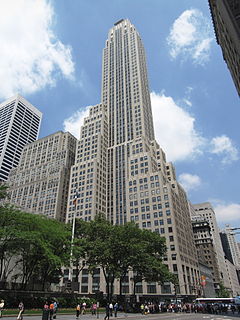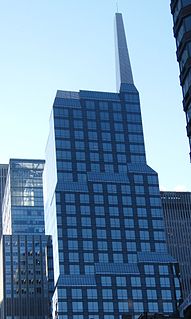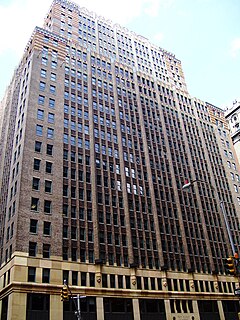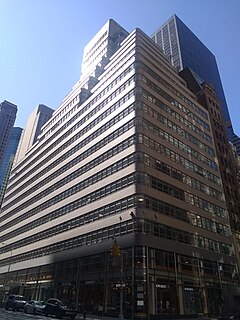
The MetLife Building is a skyscraper at Park Avenue and 45th Street, north of Grand Central Terminal, in the Midtown Manhattan neighborhood of New York City. Designed in the International style by Richard Roth, Walter Gropius, and Pietro Belluschi and completed in 1962, the MetLife Building is 808 feet (246 m) tall with 59 stories. It was advertised as the world's largest commercial office space by square footage at its opening, with 2.4 million square feet (220,000 m2) of usable office space. As of 2021, the MetLife Building remains one of the 100 tallest buildings in the United States.

The Fuller Building is a skyscraper at 57th Street and Madison Avenue in the Midtown Manhattan neighborhood of New York City. Designed by Walker & Gillette, it was erected between 1928 and 1929. The building is named for its original main occupant, the Fuller Construction Company, which moved from the Flatiron Building.

383 Madison Avenue, formerly known as the Bear Stearns Building, is a 755-foot (230 m), 47-story skyscraper in the Midtown Manhattan neighborhood of New York City. Built in 2002 for financial services firm Bear Stearns, it was designed by architect David Childs of Skidmore, Owings & Merrill (SOM). It housed Bear Stearns's world headquarters until 2008, when Bear collapsed and was sold to JPMorgan Chase. Since then, JPMorgan's investment banking division has occupied the building.

550 Madison Avenue is a postmodern skyscraper at Madison Avenue between 55th and 56th Streets in the Midtown Manhattan neighborhood of New York City. Designed by Philip Johnson and John Burgee with associate architect Simmons Architects, the building was completed in 1984 as the headquarters of AT&T and later became the American headquarters of Sony. The building consists of a 647-foot-tall (197-meter), 37-story office tower with a facade made of pink granite. It originally had a four-story granite annex to the west, which was demolished and replaced with a shorter annex in 2020.

The CBS Building, also known as Black Rock, is the headquarters of the CBS broadcasting network at 51 West 52nd Street in the Midtown Manhattan neighborhood of New York City. The 38-story, 491-foot-tall (150 m) building, the only skyscraper designed by Eero Saarinen, was constructed from 1961 to 1964. The interior spaces and furnishings were designed by Saarinen and Florence Knoll Bassett. The building previously served as the headquarters of CBS Records until the early 1990s.

270 Park Avenue, also the JPMorgan Chase Tower and Union Carbide Building, was a skyscraper in the Midtown Manhattan neighborhood of New York City. Built in 1960 for chemical company Union Carbide, it was designed by architects Gordon Bunshaft and Natalie de Blois of Skidmore, Owings & Merrill (SOM). The 52-story, 707-foot (215 m) skyscraper later became the global headquarters for JPMorgan Chase. When it was demolished in 2021, the Union Carbide Building was the tallest peacefully demolished building in the world. A taller skyscraper with the same address, to be completed in 2025, is being constructed on the site.

500 Fifth Avenue is a 60-story, 697-foot-tall (212 m) office building on the northwest corner of Fifth Avenue and 42nd Street in Midtown Manhattan, New York City. The building was designed by Shreve, Lamb & Harmon in the Art Deco style and constructed from 1929 to 1931.
590 Madison Avenue, also known as the IBM Building, is a skyscraper at 57th Street and Madison Avenue in the Midtown Manhattan neighborhood of New York City. Designed by Edward Larrabee Barnes and Associates the 41-story, 603-foot (184 m)-tall tower was developed for the technology company IBM and built from 1978 to 1983.

750 Seventh Avenue is a 36-story office building in the Midtown Manhattan neighborhood of New York City. The building was designed by Kevin Roche of Roche-Dinkeloo and developed by David and Jean Solomon. 750 Seventh Avenue occupies a site on the north side of 49th Street between Broadway and Seventh Avenue. Since 1994, the building has mostly been occupied by the offices of financial services company Morgan Stanley. The building contains a black glass facade with large signs as well as etched-glass panels. On the upper stories, the exterior has setbacks in a spiral pattern, which terminate in an offset glass pinnacle. When the building opened, several critics compared its design to a smokestack and to a glass pyramid.

3 East 57th Street, originally the L. P. Hollander Company Building, is a nine-story commercial building in the Midtown Manhattan neighborhood of New York City. It is along the northern side of 57th Street, just east of Fifth Avenue. 3 East 57th Street, constructed from 1929 to 1930, was designed by Shreve, Lamb & Harmon in an early Art Deco style.

3 Times Square, also known as the Thomson Reuters Building, is a 30-story skyscraper at Times Square in the Midtown Manhattan neighborhood of New York City. Located on Seventh Avenue between 42nd and 43rd Street, the building measures 555 feet (169 m) to its roof and 659 feet (201 m) to its spire. The building was designed by Fox & Fowle and developed by Rudin Management for news-media company Reuters. The site is owned by the New York City Economic Development Corporation, though Rudin and Reuters have a long-term leasehold on the building.

Park Avenue Plaza is an office building at 55 East 52nd Street in the Midtown Manhattan neighborhood of New York City. The 575-foot (175 m) tall, 44-story building was designed by Skidmore, Owings & Merrill (SOM) for development company Fisher Brothers and was completed in 1981. Despite its name, the building is not actually on Park Avenue, although it abuts the Racquet and Tennis Club building along the avenue. Rather, the building is in the middle of a city block, with entrances on 52nd and 53rd Streets.

608 Fifth Avenue, also known as the Goelet Building or Swiss Center Building, is an office building at Fifth Avenue and West 49th Street in the Midtown Manhattan neighborhood of New York City, adjacent to Rockefeller Center. It was designed by Victor L. S. Hafner for the Goelet family, with Edward Hall Faile as structural engineer. The facade uses elements of both the Art Deco style and the International Style, while the lobby was exclusively designed in the Art Deco style.

2 Park Avenue is a 28-story office building in the Murray Hill neighborhood of Manhattan in New York City. The structure, along the west side of Park Avenue between 32nd and 33rd Streets, was designed by Ely Jacques Kahn and was developed by Abe N. Adelson from 1926 to 1928. The building is owned by Morgan Stanley Real Estate and is a New York City designated landmark.
18 East 50th Street, also known as the Hampton Shops Building and the New York Health & Racquet Club Building, is an office building in the Midtown Manhattan neighborhood of New York City. Located on the south side of 50th Street, on the middle of the block between Fifth Avenue and Madison Avenue, it was designed by William Lawrence Rouse, Lafayette Anthony Goldstone, and Joseph L. Steinam.

488 Madison Avenue, also known as the Look Building, is a 25-story office building in the Midtown Manhattan neighborhood of New York City. It is along Madison Avenue's western sidewalk between 51st and 52nd Streets, near St. Patrick's Cathedral. 488 Madison Avenue was designed by Emery Roth & Sons in the International Style, and it was constructed and developed by Uris Brothers. The building was originally named for its primary tenant, the American magazine Look.

12 East 53rd Street, also the Fisk–Harkness House, is a building in the Midtown Manhattan neighborhood of New York City. It is along the south side of 53rd Street between Madison Avenue and Fifth Avenue. The six-story building was designed by Griffith Thomas and was constructed in 1871. It was redesigned in the Tudor-inspired Gothic Revival style in 1906 by Raleigh C. Gildersleeve.

275 Madison Avenue is a 43-story office building in the Murray Hill neighborhood of Manhattan in New York City. It is along the southeast corner of Madison Avenue and 40th Street, near Grand Central Terminal. The building, constructed from 1930 to 1931, was designed by Kenneth Franzheim in a mixture of the Art Deco and International styles.

270 Park Avenue, also known as the JPMorgan Chase Building, is a skyscraper under construction in the Midtown Manhattan neighborhood of New York City. Designed by the firm of Foster + Partners, the tower is expected to rise up to 1,388 feet (423 m), and will replace a previous skyscraper that existed at this address from 1960 until demolition was completed in 2021. Like the demolished building, the new skyscraper will be the global headquarters for JPMorgan Chase. During construction, 383 Madison Avenue is serving as the temporary headquarters. The building is planned to be completed in 2025.

200 Madison Avenue is a 25-story office building in the Murray Hill neighborhood of Manhattan in New York City. It is along the west side of Madison Avenue between 35th and 36th Streets. Designed by Warren and Wetmore, it was built from 1925 to 1926.





















